Chapter 3 Functions
3.4 Rates of Change and Behavior of Graphs
Learning Objectives
In this section, you will:
- Find the average rate of change of a function.
- Use a graph to determine where a function is increasing, decreasing, or constant.
- Use a graph to locate local maxima and local minima.
- Use a graph to locate the absolute maximum and absolute minimum.
Gasoline costs have experienced some wild fluctuations over the last several decades. Table 1 [1] lists the average cost, in dollars, of a gallon of gasoline for the years 2005–2012. The cost of gasoline can be considered as a function of year.
| [latex]y[/latex] | 2005 | 2006 | 2007 | 2008 | 2009 | 2010 | 2011 | 2012 |
| [latex]C(y)[/latex] | 2.31 | 2.62 | 2.84 | 3.30 | 2.41 | 2.84 | 3.58 | 3.68 |
If we were interested only in how the gasoline prices changed between 2005 and 2012, we could compute that the cost per gallon had increased from $2.31 to $3.68, an increase of $1.37. While this is interesting, looking at how much the price changed per year might be more useful. In this section, we will investigate changes such as these.
Finding the Average Rate of Change of a Function
The price change per year is a rate of change because it describes how an output quantity changes relative to the change in the input quantity. We can see that the price of gasoline in Table 1 did not change by the same amount each year, so the rate of change was not constant. If we use only the beginning and ending data, we would be finding the average rate of change over the specified period of time. To find the average rate of change, we divide the change in the output value by the change in the input value.
The Greek letter[latex]\text{Δ}\,[/latex](delta) signifies the change in a quantity; we read the ratio as “delta-y over delta-x” or “the change in[latex]\,y\,[/latex]divided by the change in[latex]\,x.[/latex]” Occasionally we write[latex]\,\text{Δ}f\,[/latex]instead of[latex]\,\text{Δ}y,\,[/latex]which still represents the change in the function’s output value resulting from a change to its input value. It does not mean we are changing the function into some other function.
In our example, the gasoline price increased by $1.37 from 2005 to 2012. Over 7 years, the average rate of change was
On average, the price of gas increased by about 19.6¢ each year.
Other examples of rates of change include:
- A population of rats increasing by 40 rats per week
- A car traveling 68 miles per hour (distance traveled changes by 68 miles each hour as time passes)
- A car driving 27 miles per gallon (distance traveled changes by 27 miles for each gallon)
- The current through an electrical circuit increasing by 0.125 amperes for every volt of increased voltage
- The amount of money in a college account decreasing by $4,000 per quarter
Rate of Change
A rate of change describes how an output quantity changes relative to the change in the input quantity. The units on a rate of change are “output units per input units.”
The average rate of change between two input values is the total change of the function values (output values) divided by the change in the input values.
How To
Given the value of a function at different points, calculate the average rate of change of a function for the interval between two values [latex]\,{x}_{1}\,[/latex] and [latex]\,{x}_{2}.[/latex]
- Calculate the difference [latex]{y}_{2}-{y}_{1}=\text{Δ}y.[/latex]
- Calculate the difference [latex]{x}_{2}-{x}_{1}=\text{Δ}x.[/latex]
- Find the ratio[latex]\,\frac{\text{Δ}y}{\text{Δ}x}.[/latex]
Computing an Average Rate of Change
Using the data in Table 1, find the average rate of change of the price of gasoline between 2007 and 2009.
Show Solution
In 2007, the price of gasoline was $2.84. In 2009, the cost was $2.41. The average rate of change is
Analysis
Note that a decrease is expressed by a negative change or “negative increase.” A rate of change is negative when the output decreases as the input increases or when the output increases as the input decreases.
Try It
Using the data in Table 1, find the average rate of change between 2005 and 2010.
Show Solution
[latex]\frac{$2.84-$2.31}{5\text{ years}}=\frac{\$0.53}{5\text{ years}}=$0.106\,[/latex] per year.
Computing Average Rate of Change from a Graph
Given the function [latex]\,g\left(t\right)\,[/latex] shown in Figure 1, find the average rate of change on the interval [latex]\,\left[-1,2\right].[/latex]
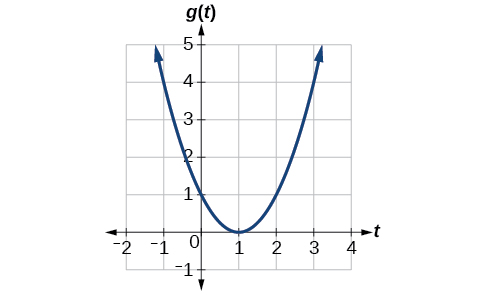
Show Solution
At [latex]t=-1,[/latex] Figure 2 shows [latex]g\left(-1\right)=4.[/latex] At[latex]\,t=2,[/latex] the graph shows [latex]g\left(2\right)=1.[/latex]
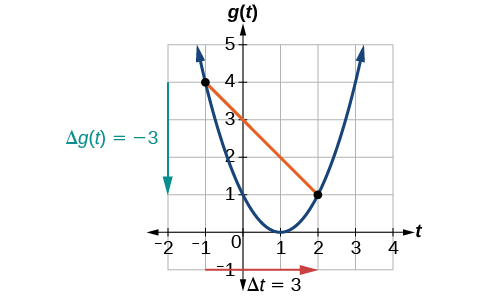
The horizontal change[latex]\,\text{Δ}t=3\,[/latex]is shown by the red arrow, and the vertical change [latex]\text{Δ}g\left(t\right)=-3[/latex] is shown by the turquoise arrow. The average rate of change is shown by the slope of the orange line segment. The output changes by –3 while the input changes by 3, giving an average rate of change of
Analysis
Note that the order we choose is very important. If, for example, we use[latex]\,\frac{{y}_{2}-{y}_{1}}{{x}_{1}-{x}_{2}},\,[/latex]we will not get the correct answer. Decide which point will be 1 and which point will be 2, and keep the coordinates fixed as[latex]\,\left({x}_{1},{y}_{1}\right)\,[/latex] and[latex]\,\left({x}_{2},{y}_{2}\right).[/latex]
Computing Average Rate of Change from a Table
After picking up a friend who lives 10 miles away and leaving on a trip, Anna records her distance from home over time. The values are shown in Table 2. Find her average speed over the first 6 hours.
| t (hours) | 0 | 1 | 2 | 3 | 4 | 5 | 6 | 7 |
| D(t) (miles) | 10 | 55 | 90 | 153 | 214 | 240 | 292 | 300 |
Show Solution
Here, the average speed is the average rate of change. She traveled 282 miles in 6 hours.
Analysis
Because the speed is not constant, the average speed depends on the interval chosen. For the interval [2,3], the average speed is 63 miles per hour.
Computing Average Rate of Change for a Function Expressed as a Formula
Compute the average rate of change of [latex]f\left(x\right)={x}^{2}-\frac{1}{x}[/latex] on the interval [latex]\text{[2,}\,\text{4].}[/latex]
Show Solution
We can start by computing the function values at each endpoint of the interval.
Now we compute the average rate of change.
Try It
Find the average rate of change of [latex]f\left(x\right)=x-2\sqrt{x}[/latex] on the interval [latex]\left[1,\,9\right].[/latex]
Show Solution
[latex]\frac{1}{2}[/latex]
Finding the Average Rate of Change of a Force
The electrostatic force[latex]\,F,[/latex] measured in newtons, between two charged particles can be related to the distance between the particles[latex]\,d,[/latex] in centimeters, by the formula[latex]\,F\left(d\right)=\frac{2}{{d}^{2}}.[/latex] Find the average rate of change of force if the distance between the particles is increased from 2 cm to 6 cm.
Show Solution
We are computing the average rate of change of[latex]\,F\left(d\right)=\frac{2}{{d}^{2}}\,[/latex]on the interval[latex]\,\left[2,6\right].[/latex]
The average rate of change is [latex]-\frac{1}{9}[/latex] newton per centimeter.
Finding an Average Rate of Change as an Expression
Find the average rate of change of [latex]g\left(t\right)={t}^{2}+3t+1[/latex] on the interval [latex]\left[0,\,a\right].[/latex] The answer will be an expression involving [latex]a[/latex] in simplest form.
Show Solution
We use the average rate of change formula:
| = [latex]\frac{g\left(a\right)-g\left(0\right)}{a-0}[/latex] | Average rate of change formula. |
| = [latex]\frac{\left({a}^{2}+3a+1\right)-\left({0}^{2}+3\left(0\right)+1\right)}{a-0}[/latex] | Simplify. |
| = [latex]\frac{{a}^{2}+3a+1-1}{a}[/latex] | Simplify and factor. |
| = [latex]\frac{a\left(a+3\right)}{a}[/latex] | Divide by the common factor [latex]a[/latex]. |
| = [latex]a+3[/latex] |
This result tells us the average rate of change in terms of[latex]\,a\,[/latex]between[latex]\,t=0\,[/latex]and any other point[latex]\,t=a.\,[/latex]For example, on the interval[latex]\,\left[0,5\right],\,[/latex]the average rate of change would be[latex]\,5+3=8.[/latex]
Try It
Find the average rate of change of[latex]\,f\left(x\right)={x}^{2}+2x-8\,[/latex] on the interval[latex]\,\left[5,a\right]\,[/latex]in simplest forms in terms
Show Solution
[latex]\,a+7\,[/latex]
Using a Graph to Determine Where a Function Is Increasing, Decreasing, or Constant and to Locate Local Maxima and Local Minima
As part of exploring how functions change, we can identify intervals over which the function is changing in specific ways. We say that a function is increasing on an interval if the function values increase as the input values increase within that interval. Similarly, a function is decreasing on an interval if the function values decrease as the input values increase over that interval. The average rate of change of an increasing function is positive, and the average rate of change of a decreasing function is negative. Figure 3 shows examples of increasing and decreasing intervals on a function.
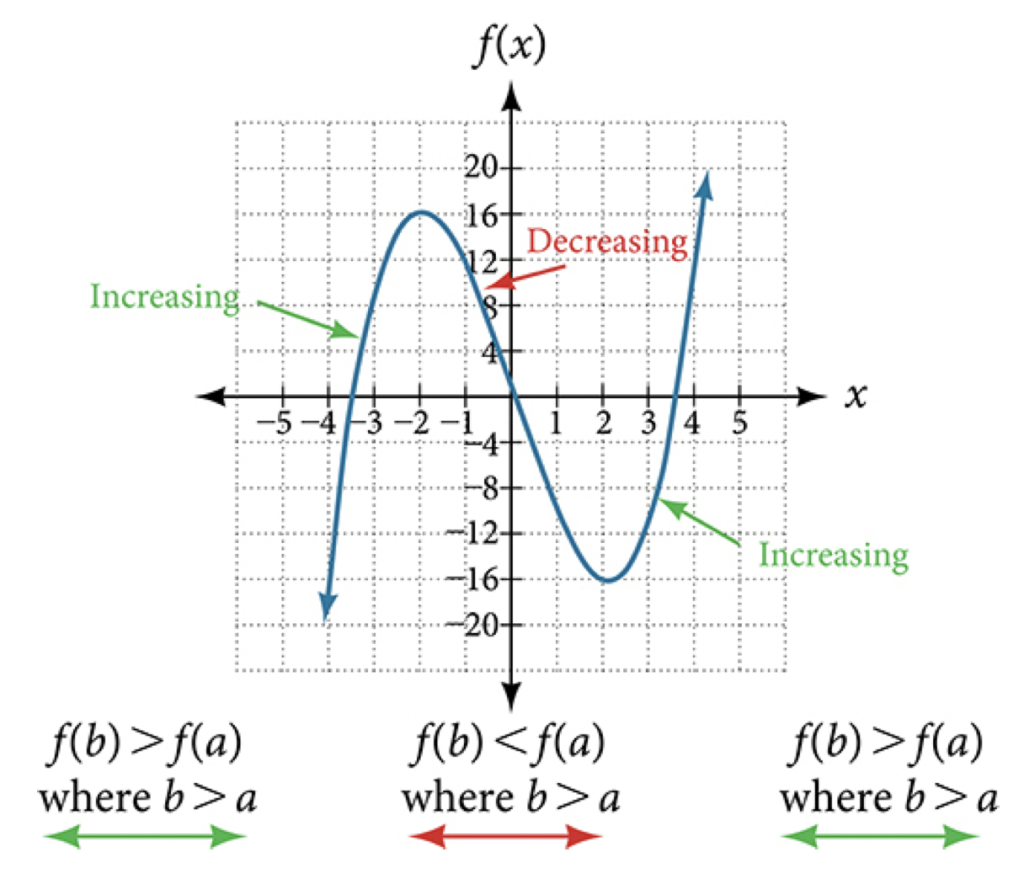
[/latex] is increasing on [latex](-\infty, -2) \cup (2, \infty)[/latex] and is decreasing on [latex](-2, 2)[/latex].
While some functions are increasing (or decreasing) over their entire domain, many others are not. A value of the input where a function changes from increasing to decreasing (as we go from left to right—that is, as the input variable increases) is called a local maximum. If a function has more than one, we say it has local maxima. Similarly, a value of the input where a function changes from decreasing to increasing as the input variable increases is called a local minimum. The plural form is “local minima.” Together, local maxima and minima are called local extrema, or local extreme values, of the function. (The singular form is “extremum.”) Often, the term local is replaced by the term relative. In this text, we will use the term local.
Clearly, a function is neither increasing nor decreasing on an interval where it is constant. A function is also neither increasing nor decreasing at extrema. Note that we have to speak of local extrema because any given local extremum as defined here is not necessarily the highest maximum or lowest minimum in the function’s entire domain.
For the function whose graph is shown in Figure 4, the local maximum is 16, and it occurs at [latex]\,x=-2.\,[/latex] The local minimum is [latex]\,-16\,[/latex] and it occurs at [latex]\,x=2.[/latex]

To locate the local maxima and minima from a graph, we need to observe the graph to determine where the graph attains its highest and lowest points, respectively, within an open interval. Like the summit of a roller coaster, the graph of a function is higher at a local maximum than at nearby points on both sides. The graph will also be lower at a local minimum than at neighboring points. Figure 5 illustrates these ideas for a local maximum.
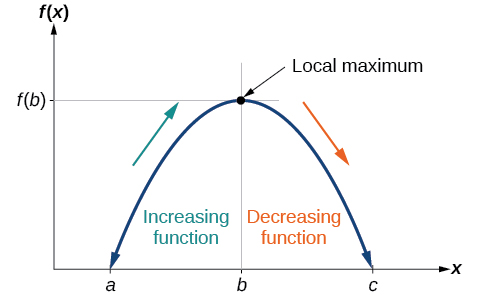
These observations lead us to a formal definition of local extrema.
Local Minima and Local Maxima
A function [latex]\,f\,[/latex] is an increasing function on an open interval if [latex]\,f\left(b\right)>f\left(a\right)\,[/latex] for any two input values [latex]\,a\,[/latex]and[latex]\,b\,[/latex] in the given interval where [latex]\,b>a.[/latex]
A function[latex]\,f\,[/latex] is a decreasing function on an open interval if [latex]\,f\left(b\right)[/latex] < [latex]f\left(a\right)\,[/latex] for any two input values [latex]\,a\,[/latex] and [latex]\,b\,[/latex] in the given interval where [latex]\,b>a.[/latex]
A function [latex]f[/latex] has a local maximum at [latex]\,x=b[/latex] if there exists an interval [latex]\,\left(a,c\right)[/latex] with a<b<c such that, for any [latex]x[/latex] in the interval [latex]\left(a,c\right),[/latex][latex]f\left(x\right)\le f\left(b\right).[/latex] Likewise, [latex]f[/latex] has a local minimum at [latex]x=b[/latex] if there exists an interval [latex]\left(a,c\right)[/latex] with [latex]a \lt b \lt c[/latex] such that, for any [latex]x[/latex] in the interval [latex]\left(a,c\right),[/latex][latex]f\left(x\right)\ge f\left(b\right).[/latex]
Finding Increasing and Decreasing Intervals on a Graph
Given the function [latex]\,p\left(t\right)\,[/latex] in Figure 6, identify the intervals on which the function appears to be increasing.
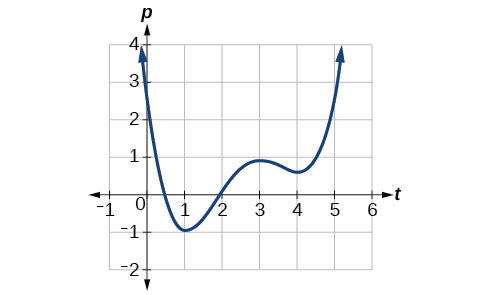
Show Solution
We see that the function is not constant on any interval. The function is increasing where it slants upward as we move to the right and decreasing where it slants downward as we move to the right. The function appears to be increasing from[latex]\,t=1\,[/latex]to[latex]\,t=3\,[/latex]and from[latex]\,t=4\,[/latex]on.
In interval notation, we would say the function appears to be increasing on the interval [latex](1,3)[/latex] and the interval [latex]\left(4,\infty \right).[/latex]
Analysis
Notice in this example that we used open intervals (intervals that do not include the endpoints), because the function is neither increasing nor decreasing at [latex]\,t=1[/latex],[latex]\,t=3[/latex], and [latex]\,t=4\,[/latex]. These points are the local extrema (two minima and a maximum).
Finding Local Extrema from a Graph
Graph the function[latex]\,f\left(x\right)=\frac{2}{x}+\frac{x}{3}.\,[/latex]Then use the graph to estimate the local extrema of the function and to determine the intervals on which the function is increasing.
Show Solution
Using technology, we find that the graph of the function looks like that in Figure 7. It appears there is a low point, or local minimum, between [latex]\,x=2\,[/latex] and [latex]\,x=3,\,[/latex] and a mirror-image high point, or local maximum, somewhere between [latex]\,x=-3\,[/latex] and [latex]\,x=-2.[/latex]

Analysis
Most graphing calculators and graphing utilities can estimate the location of maxima and minima. Figure 8 provides screen images from two different technologies, showing the estimate for the local maximum and minimum.

Based on these estimates, the function is increasing on the interval[latex]\,(-\infty \text{,}-\text{2}\text{.449)}\,[/latex] and [latex]\,\left(2.449\text{,}\infty \right).\,[/latex] Notice that, while we expect the extrema to be symmetric, the two different technologies agree only up to four decimals due to the differing approximation algorithms used by each. (The exact location of the extrema is at[latex]\,±\sqrt{6},\,[/latex]but determining this requires calculus.)
Try It
Graph the function[latex]\,f\left(x\right)={x}^{3}-6{x}^{2}-15x+20\,[/latex]to estimate the local extrema of the function. Use these to determine the intervals on which the function is increasing and decreasing.
Show Solution
The local maximum appears to occur at[latex]\,\left(-1,28\right),\,[/latex]and the local minimum occurs at[latex]\,\left(5,-80\right).\,[/latex]The function is increasing on[latex]\,\left(-\infty ,-1\right)\cup \left(5,\infty \right)\,[/latex]and decreasing on[latex]\,\left(-1,5\right).[/latex]
Finding Local Maxima and Minima from a Graph
For the function [latex]\,f\,[/latex] whose graph is shown in Figure 9, find all local maxima and minima.
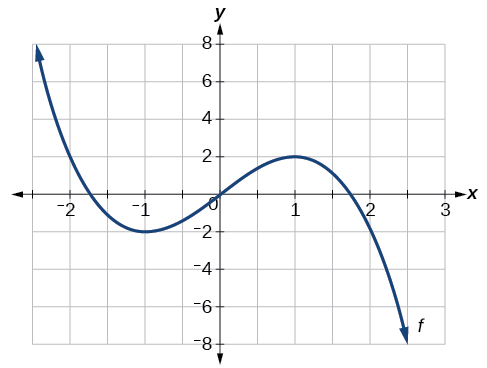
Show Solution
Observe the graph of[latex]\,f.\,[/latex]The graph attains a local maximum at[latex]\,x=1\,[/latex]because it is the highest point in an open interval around[latex]\,x=1.[/latex]The local maximum is the[latex]\,y[/latex]-coordinate at[latex]\,x=1,\,[/latex]which is[latex]\,2.[/latex]
The graph attains a local minimum at[latex]\text{ }x=-1\text{ }[/latex]because it is the lowest point in an open interval around[latex]\,x=-1.\,[/latex]The local minimum is the y-coordinate at[latex]\,\,x=-1,\,\,[/latex]which is[latex]\,\,-2.[/latex]
Analyzing the Toolkit Functions for Increasing or Decreasing Intervals
We will now return to our toolkit functions and discuss their graphical behavior in Figure 10, Figure 11, and Figure 12.
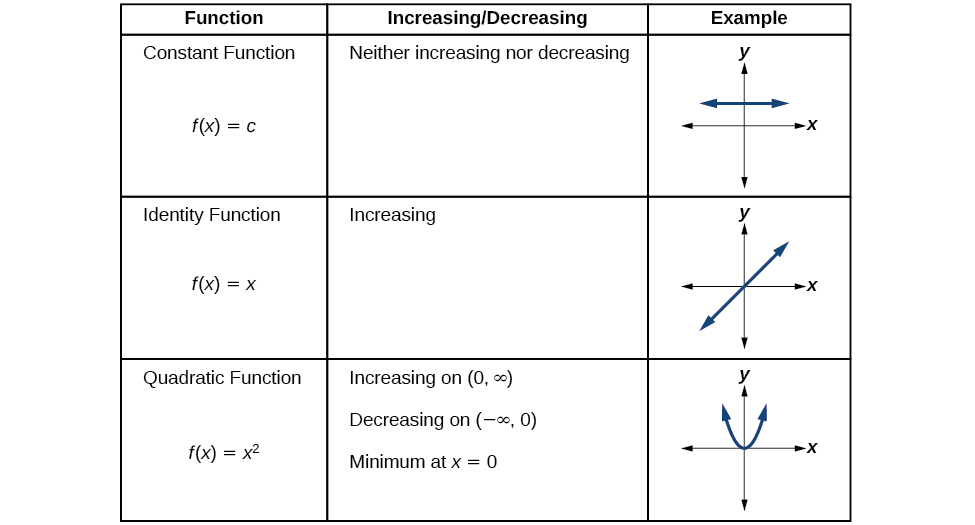
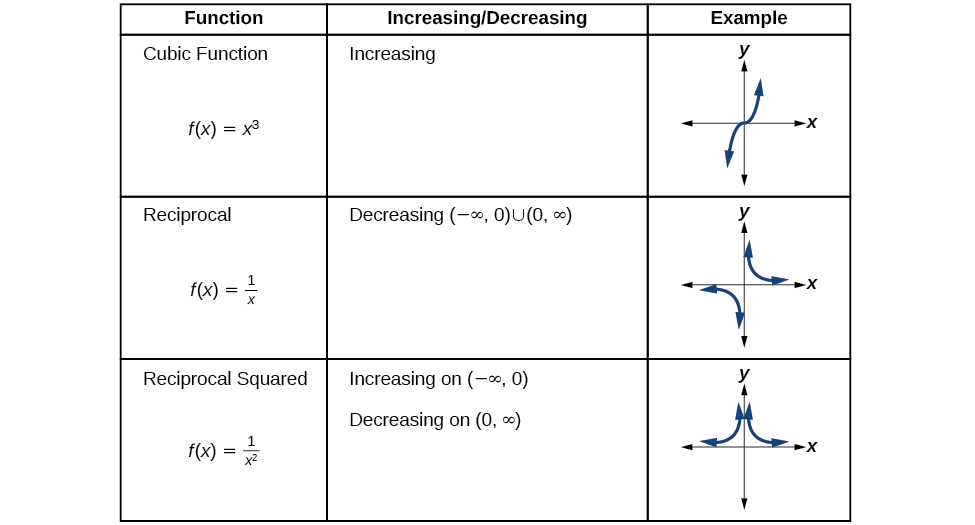
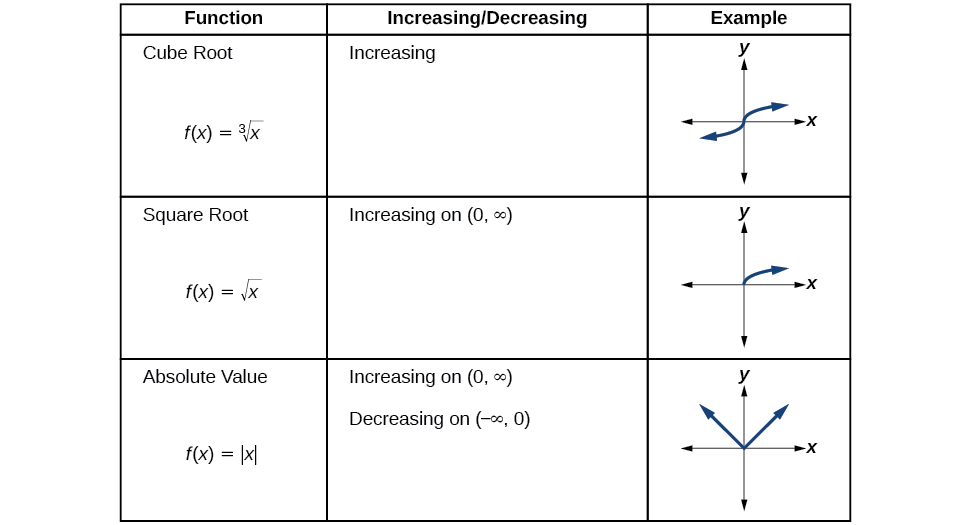
Use A Graph to Locate the Absolute Maximum and Absolute Minimum
There is a difference between locating the highest and lowest points on a graph in a region around an open interval (locally) and locating the highest and lowest points on the graph for the entire domain. The[latex]\,y\text{-}[/latex]coordinates (output) at the highest and lowest points are called the absolute maximum and absolute minimum, respectively.
To locate absolute maxima and minima from a graph, we need to observe the graph to determine where the graph attains its highest and lowest points on the domain of the function. See Figure 13.
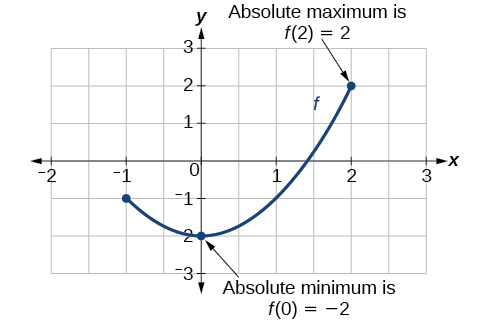
Not every function has an absolute maximum or minimum value. The toolkit function [latex]\,f\left(x\right)={x}^{3}\,[/latex] is one such function.
Absolute Maxima and Minima
The absolute maximum of[latex]\,f\,[/latex]at[latex]\,x=c\,[/latex]is[latex]\,f\left(c\right)\,[/latex]where[latex]\,f\left(c\right)\ge f\left(x\right)\,[/latex]for all[latex]\,x\,[/latex]in the domain of[latex]\,f.[/latex]
The absolute minimum of[latex]\,f\,[/latex]at[latex]\,x=d\,[/latex]is[latex]\,f\left(d\right)\,[/latex]where[latex]\,f\left(d\right)\le f\left(x\right)\,[/latex]for all[latex]\,x\,[/latex]in the domain of[latex]\,f.[/latex]
Finding Absolute Maxima and Minima from a Graph
For the function [latex]\,f\,[/latex] shown below, find all absolute maxima and minima.
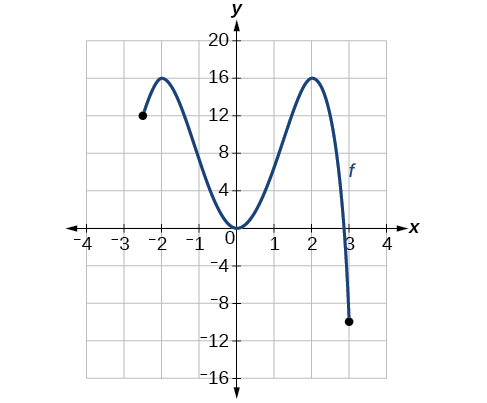
Show Solution
Observe the graph of[latex]\,f.\,[/latex]The graph attains an absolute maximum in two locations,[latex]\,x=-2\,[/latex]and[latex]\,x=2,\,[/latex]because at these locations, the graph attains its highest point on the domain of the function. The absolute maximum is the y-coordinate at[latex]\,x=-2\,[/latex]and[latex]\,x=2,\,[/latex]which is[latex]\,16.[/latex]
The graph attains an absolute minimum at[latex]\,x=3,\,[/latex]because it is the lowest point on the domain of the function’s graph. The absolute minimum is the y-coordinate at[latex]\,x=3,[/latex]which is[latex]-10.[/latex]
Key Equations
| Average rate of change | [latex]\frac{\Delta y}{\Delta x}=\frac{f\left({x}_{2}\right)-f\left({x}_{1}\right)}{{x}_{2}-{x}_{1}}[/latex] |
Key Concepts
- A rate of change relates a change in an output quantity to a change in an input quantity. The average rate of change is determined using only the beginning and ending data.
- Identifying points that mark the interval on a graph can be used to find the average rate of change.
- Comparing pairs of input and output values in a table can also be used to find the average rate of change.
- An average rate of change can also be computed by determining the function values at the endpoints of an interval described by a formula.
- The average rate of change can sometimes be determined as an expression.
- A function is increasing where its rate of change is positive and decreasing where its rate of change is negative.
- A local maximum is where a function changes from increasing to decreasing and has an output value larger (more positive or less negative) than output values at neighboring input values.
- A local minimum is where the function changes from decreasing to increasing (as the input increases) and has an output value smaller (more negative or less positive) than output values at neighboring input values.
- Minima and maxima are also called extrema.
- We can find local extrema from a graph.
- The highest and lowest points on a graph indicate the maxima and minima.
Section Exercises
Verbal
- Can the average rate of change of a function be constant?
Show Solution
Yes, the average rate of change of all linear functions is constant.
- If a function [latex]\,f\,[/latex] is increasing on [latex]\,\left(a,b\right)\,[/latex] and decreasing on [latex]\,\left(b,c\right),\,[/latex] then what can be said about the local extremum of [latex]\,f\,[/latex]on[latex]\,\left(a,c\right)?\,[/latex]
- How are the absolute maximum and minimum similar to and different from the local extrema?
Show Solution
The absolute maximum and minimum relate to the entire graph, whereas the local extrema relate only to a specific region around an open interval.
- How does the graph of the absolute value function compare to the graph of the quadratic function, [latex]\,y={x}^{2},\,[/latex] in terms of increasing and decreasing intervals?
Algebraic
For the following exercises, find the average rate of change of each function on the interval specified for real numbers [latex]\,b\,[/latex] or [latex]\,h[/latex] in simplest form.
- [latex]f\left(x\right)=4{x}^{2}-7\,[/latex] on [latex]\,\left[1,\text{ }b\right][/latex]
Show Solution
[latex]4\left(b+1\right)[/latex]
- [latex]g\left(x\right)=2{x}^{2}-9\,[/latex] on [latex]\,\left[4,\text{ }b\right][/latex]
- [latex]p\left(x\right)=3x+4\,[/latex] on [latex]\,\left[2,\text{ }2+h\right][/latex]
Show Solution
3
- [latex]k\left(x\right)=4x-2\,[/latex] on [latex]\,\left[3,\text{ }3+h\right][/latex]
- [latex]f\left(x\right)=2{x}^{2}+1\,[/latex] on [latex]\,\left[x,x+h\right][/latex]
Show Solution
[latex]4x+2h[/latex]
- [latex]g\left(x\right)=3{x}^{2}-2\,[/latex] on [latex]\,\left[x,x+h\right][/latex]
- [latex]a\left(t\right)=\frac{1}{t+4}\,[/latex] on [latex]\,\left[9,9+h\right][/latex]
Show Solution
[latex]\frac{-1}{13\left(13+h\right)}[/latex]
- [latex]b\left(x\right)=\frac{1}{x+3}\,[/latex] on [latex]\,\left[1,1+h\right][/latex]
- [latex]j\left(x\right)=3{x}^{3}\,[/latex] on [latex]\,\left[1,1+h\right][/latex]
Show Solution
[latex]3{h}^{2}+9h+9[/latex]
- [latex]r\left(t\right)=4{t}^{3}\,[/latex] on [latex]\,\left[2,2+h\right][/latex]
- [latex]\frac{f\left(x+h\right)-f\left(x\right)}{h}\,[/latex]given[latex]\,f\left(x\right)=2{x}^{2}-3x\,[/latex] on [latex]\,\left[x,x+h\right][/latex]
Show Solution
[latex]4x+2h-3[/latex]
Graphical
For the following exercises, consider the graph of [latex]\,f\,[/latex] shown in Figure below.

- Estimate the average rate of change from [latex]\,x=1\,[/latex] to [latex]\,x=4.[/latex]
- Estimate the average rate of change from [latex]\,x=2\,[/latex] to [latex]\,x=5.[/latex]
Show Solution
[latex]\frac{4}{3}[/latex]
For the following exercises, use the graph of each function to estimate the intervals on which the function is increasing or decreasing.
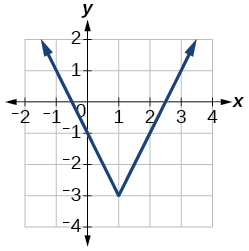
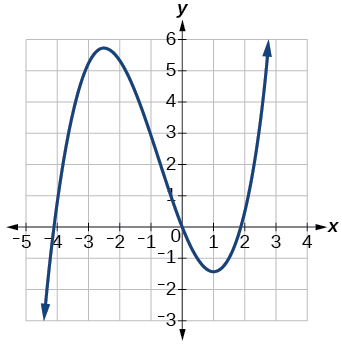
Show Solution
increasing on[latex]\,\left(-\infty ,-2.5\right)\cup \left(1,\infty \right),\,[/latex]decreasing on[latex]\,\left(-2.5,\text{ }1\right)[/latex]
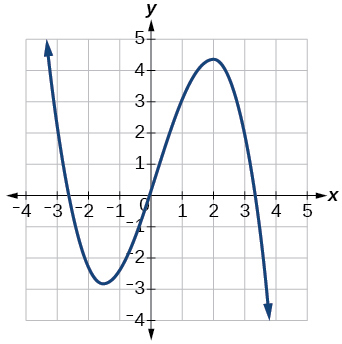
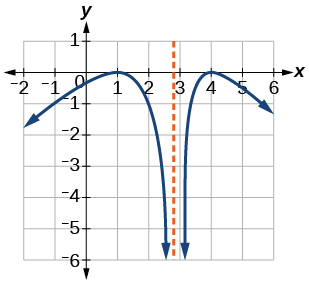
Show Solution
increasing on [latex]\,\left(-\infty ,1\right)\cup \left(3,4\right),\,[/latex] decreasing on[latex]\,\left(1,3\right)\cup \left(4,\infty \right)[/latex]
For the following exercises, consider the graph shown in the Figure below.

- Estimate the intervals where the function is increasing or decreasing.
- Estimate the point(s) at which the graph of [latex]\,f\,[/latex] has a local maximum or a local minimum.
Show Solution
local maximum:[latex]\,\left(-3,\text{ }60\right),\,[/latex] local minimum:[latex]\,\left(3,\text{ }-60\right)\,[/latex]
For the following exercises, consider the graph in the Figure below.
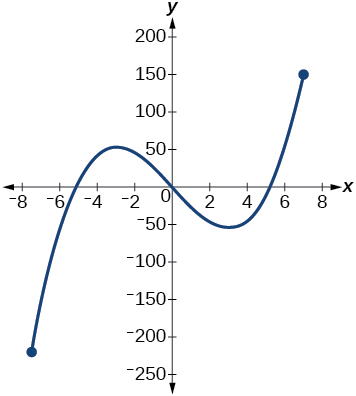
- If the complete graph of the function is shown, estimate the intervals where the function is increasing or decreasing.
- If the complete graph of the function is shown, estimate the absolute maximum and absolute minimum.
Show Solution
absolute maximum at approximately [latex]\,\left(7,\text{ }150\right),\,[/latex] absolute minimum at approximately [latex]\,\left(-7.5,\text{ }-220\right)[/latex]
Numeric
- Table 3 gives the annual sales (in millions of dollars) of a product from 1998 to 2006. What was the average rate of change of annual sales (a) between 2001 and 2002, and (b) between 2001 and 2004?
| Year | Sales
(millions of dollars) |
|---|---|
| 1998 | 201 |
| 1999 | 219 |
| 2000 | 233 |
| 2001 | 243 |
| 2002 | 249 |
| 2003 | 251 |
| 2004 | 249 |
| 2005 | 243 |
| 2006 | 233 |
- Table 4 gives the population of a town (in thousands) from 2000 to 2008. What was the average rate of change of population (a) between 2002 and 2004, and (b) between 2002 and 2006?
| Year | Population (thousands) |
| 2000 | 87 |
| 2001 | 84 |
| 2002 | 83 |
| 2003 | 80 |
| 2004 | 77 |
| 2005 | 76 |
| 2006 | 78 |
| 2007 | 81 |
| 2008 | 85 |
Show Solution
a. –3000; b. –1250
For the following exercises, find the average rate of change of each function on the interval specified.
- [latex]f\left(x\right)={x}^{2}\,[/latex] on [latex]\,\left[1,\text{ }5\right][/latex]
- [latex]h\left(x\right)=5-2{x}^{2}\,[/latex] on [latex]\,\left[-2,\text{4}\right][/latex]
Show Solution
-4
- [latex]q\left(x\right)={x}^{3}\,[/latex] on [latex]\,\left[-4,\text{2}\right][/latex]
- [latex]g\left(x\right)=3{x}^{3}-1\,[/latex] on [latex]\,\left[-3,\text{3}\right][/latex]
Show Solution
27
- [latex]y=\frac{1}{x}\,[/latex]on[latex]\,\left[1,\text{ 3}\right][/latex]
- [latex]p\left(t\right)=\frac{\left({t}^{2}-4\right)\left(t+1\right)}{{t}^{2}+3}\,[/latex] on [latex]\,\left[-3,\text{1}\right][/latex]
Show Solution
–0.167
- [latex]k\left(t\right)=6{t}^{2}+\frac{4}{{t}^{3}}\,[/latex]on[latex]\,\left[-1,3\right][/latex]
Technology
For the following exercises, use a graphing utility to estimate the local extrema of each function and to estimate the intervals on which the function is increasing and decreasing.
- [latex]f\left(x\right)={x}^{4}-4{x}^{3}+5[/latex]
Show Solution
Local minimum at[latex]\,\left(3,-22\right),\,[/latex]decreasing on[latex]\,\left(-\infty ,\text{ }3\right),\,[/latex]increasing on[latex]\,\left(3,\text{ }\infty \right)\,[/latex]
- [latex]h\left(x\right)={x}^{5}+5{x}^{4}+10{x}^{3}+10{x}^{2}-1[/latex]
- [latex]g\left(t\right)=t\sqrt{t+3}[/latex]
Show Solution
Local minimum at[latex]\,\left(-2,-2\right),\,[/latex]decreasing on[latex]\,\left(-3,-2\right),\,[/latex]increasing on[latex]\,\left(-2,\text{ }\infty \right)[/latex]
- [latex]k\left(t\right)=3{t}^{\frac{2}{3}}-t[/latex]
- [latex]m\left(x\right)={x}^{4}+2{x}^{3}-12{x}^{2}-10x+4[/latex]
Show Solution
Local maximum at[latex]\,\left(-0.5,\text{ }6\right),\,[/latex]local minima at[latex]\,\left(-3.25,-47\right)\,[/latex]and[latex]\,\left(2.1,-32\right),\,[/latex]decreasing on[latex]\,\left(-\infty ,-3.25\right)\,[/latex]and[latex]\,\left(-0.5,\text{ }2.1\right),\,[/latex]increasing on[latex]\,\left(-3.25,\text{ }-0.5\right)\,[/latex]and[latex]\,\left(2.1,\text{ }\infty \right)\,[/latex]
- [latex]n\left(x\right)={x}^{4}-8{x}^{3}+18{x}^{2}-6x+2[/latex]
Extension
- The graph of the function[latex]\,f\,[/latex] is shown below.
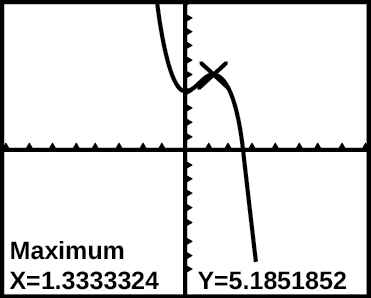
Based on the calculator screenshot, the point [latex]\,\left(1.333,\text{ }5.185\right)\,[/latex]
is which of the following?
- a relative (local) maximum of the function
- the vertex of the function
- the absolute maximum of the function
- a zero of the function
Show Solution
A
- Let [latex]f\left(x\right)=\frac{1}{x}.[/latex] Find a number [latex]\,c\,[/latex] such that the average rate of change of the function [latex]\,f\,[/latex] on the interval [latex]\,\left(1,c\right)\,[/latex]is[latex]\,-\frac{1}{4}.[/latex]
- Let [latex]\,f\left(x\right)=\frac{1}{x}[/latex]. Find the number [latex]\,b\,[/latex] such that the average rate of change of [latex]\,f\,[/latex] on the interval [latex]\,\left(2,b\right)\,[/latex]is[latex]\,-\frac{1}{10}.[/latex]
Show Solution
[latex]b=5[/latex]
Real-World Applications
- At the start of a trip, the odometer on a car read 21,395. At the end of the trip, 13.5 hours later, the odometer read 22,125. Assume the scale on the odometer is in miles. What is the average speed the car traveled during this trip?
- A driver of a car stopped at a gas station to fill up his gas tank. He looked at his watch, and the time read exactly 3:40 p.m. At this time, he started pumping gas into the tank. At exactly 3:44, the tank was full and he noticed that he had pumped 10.7 gallons. What is the average rate of flow of the gasoline into the gas tank?
Show Solution
2.7 gallons per minute
- Near the surface of the moon, the distance that an object falls is a function of time. It is given by[latex]\,d\left(t\right)=2.6667{t}^{2},\,[/latex]where[latex]\,t\,[/latex]is in seconds and[latex]\,d\left(t\right)\,[/latex]is in feet. If an object is dropped from a certain height, find the average velocity of the object from[latex]\,t=1\,[/latex]to[latex]\,t=2.[/latex]
- The graph in Figure below illustrates the decay of a radioactive substance over [latex]\,t\,[/latex] days.
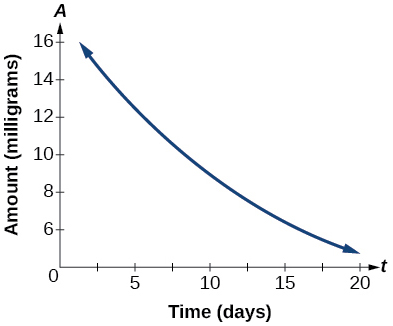
Use the graph to estimate the average decay rate from [latex]\,t=5\,[/latex] to [latex]\,t=15.[/latex]
Show Solution
approximately –0.6 milligrams per day
Glossary
- absolute maximum
- the greatest value of a function over an interval
- absolute minimum
- the lowest value of a function over an interval
- average rate of change
- the difference in the output values of a function found for two values of the input divided by the difference between the inputs
- decreasing function
- a function is decreasing in some open interval if [latex]\,f\left(b\right) \,[/latex] < [latex]f\left(a\right)\,[/latex] for any two input values [latex]\,a\,[/latex] and [latex]\,b\,[/latex] in the given interval where [latex]\,b>a[/latex]
- increasing function
- a function is increasing in some open interval if[latex]\,f\left(b\right)>f\left(a\right)\,[/latex]for any two input values[latex]\,a\,[/latex]and[latex]\,b\,[/latex]in the given interval where[latex]\,b>a[/latex]
- local extrema
- collectively, all of a function's local maxima and minima
- local maximum
- a value of the input where a function changes from increasing to decreasing as the input value increases.
- local minimum
- a value of the input where a function changes from decreasing to increasing as the input value increases.
- rate of change
- the change of an output quantity relative to the change of the input quantity
Media Attributions
- 3.4 Figure 1 © OpenStax Algebra and Trigonometry, 2e is licensed under a CC BY (Attribution) license
- 3.4 Figure 2 © OpenStax Algebra and Trigonometry, 2e is licensed under a CC BY (Attribution) license
- 3.4 Figure 3 © OpenStax Algebra and Trigonometry, 2e is licensed under a CC BY (Attribution) license
- 3.4 Figure 4 © OpenStax Algebra and Trigonometry, 2e is licensed under a CC BY (Attribution) license
- 3.4 Figure 5 © OpenStax Algebra and Trigonometry, 2e is licensed under a CC BY (Attribution) license
- 3.4 Figure 6 © OpenStax Algebra and Trigonometry, 2e is licensed under a CC BY (Attribution) license
- 3.4 Figure 7 © OpenStax Algebra and Trigonometry, 2e is licensed under a CC BY (Attribution) license
- 3.4 Figure 8 © OpenStax Algebra and Trigonometry, 2e is licensed under a CC BY (Attribution) license
- 3.4 Figure 9 © OpenStax Algebra and Trigonometry, 2e is licensed under a CC BY (Attribution) license
- 3.4 Figure 10 © OpenStax Algebra and Trigonometry, 2e is licensed under a CC BY (Attribution) license
- 3.4 Figure 11 © OpenStax Algebra and Trigonometry, 2e is licensed under a CC BY (Attribution) license
- 3.4 Figure 12 © OpenStax Algebra and Trigonometry, 2e is licensed under a CC BY (Attribution) license
- 3.4 Figure 13 © OpenStax Algebra and Trigonometry, 2e is licensed under a CC BY (Attribution) license
- 3.4 Figure 14 © OpenStax Algebra and Trigonometry, 2e is licensed under a CC BY (Attribution) license
- 3.4-Exercise-16 © OpenStax Algebra and Trigonometry, 2e is licensed under a CC BY (Attribution) license
- 3.4-Exercise-18 © OpenStax Algebra and Trigonometry, 2e is licensed under a CC BY (Attribution) license
- 3.4-Exercise-19 © OpenStax Algebra and Trigonometry, 2e is licensed under a CC BY (Attribution) license
- 3.4-Exercise-20 © OpenStax Algebra and Trigonometry, 2e is licensed under a CC BY (Attribution) license
- 3.4-Exercise-21 © OpenStax Algebra and Trigonometry, 2e is licensed under a CC BY (Attribution) license
- 3.4-Exercise-22 © OpenStax Algebra and Trigonometry, 2e is licensed under a CC BY (Attribution) license
- 3.4 Exercise 24 © OpenStax Algebra and Trigonometry, 2e is licensed under a CC BY (Attribution) license
- 3.4 Exercise 41 © OpenStax Algebra and Trigonometry, 2e is licensed under a CC BY (Attribution) license
- 3.4-Exercise-47 © OpenStax Algebra and Trigonometry, 2e is licensed under a CC BY (Attribution) license
- http://www.eia.gov/totalenergy/data/annual/showtext.cfm?t=ptb0524. Accessed 3/5/2014. ↵

